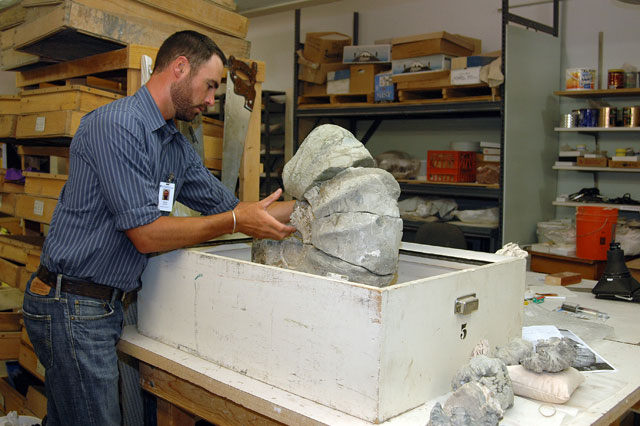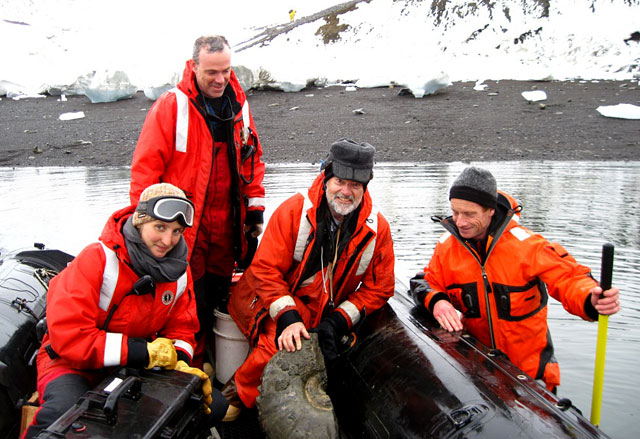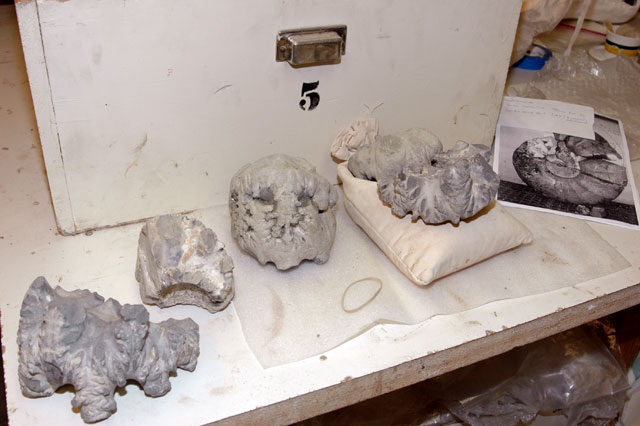Rare findGiant ammonite from Antarctica donated to Denver science museumPosted August 12, 2011
It’s not very often that Antarctic fossil hunters haul in a whopper from the sea. But the 70-million-year-old ammonite that was spotted in about a meter of water only hours before a research expedition to the Antarctic Peninsula was scheduled to end turned out to be a rare find. It may not only be the largest of its kind found in Antarctica, but possibly the first-ever where the jaws (a parrot-like beak) of the animal were encased in the fossil. “Finding the jaws in place shows that this particular ammonite has its soft parts present within the fossil shell, and entirely new information about the diet, age, and predators on these mysterious creatures will be gleaned from this exquisite specimen,” said Peter Ward Ward is the co-principal investigator on a project looking at possible extinctions that occurred prior to a major die-off 65 million years ago that many scientists believe was caused by the impact of an asteroid. Ammonites are close relatives of the living chambered nautilus. They sported a ribbed, spiral shell, and were able to move by a sort of jet propulsion by expelling water through an opening in their shell. They lived in the ocean from about 240 to 65 million years ago, when they went extinct along with the non-avian dinosaurs. “The ammonites are important because they evolved so quickly, and they also have this high extinction predilection. They get totally wiped out by the impact,” Ward explained. The fossils are also useful to scientists as index fossils, linking their location in a rock outcrop with specific geological periods. The 150-kilogram specimen was found while a team of scientists, including Ward, and support personnel were cruising through the shallow waters offshore of James Ross Island’s Santa Martha Cove during low tide. Dubbed the Giant Ammonite Graveyard by Ward during a visit to the area in 2009 with colleagues from Argentina, the team had already recovered several other “whoppers” during the previous trip. The giant ammonites are fairly easy to spot from the boat thanks to their light ash-gray color that contrasts with the dark mud on which they rest. “Here’s this huge wagon wheel sitting in three feet of water,” Ward recalled. Harold “Skip” Owen, one of the marine technicians in the party’s small inflatable boat, jumped into the sea in his cold-water immersion suit and began to help haul the specimen aboard. It was found in several large chunks. Ward donated the find to Joe Sertich Curator of Vertebrate Paleontology at the Denver Museum of Nature and Science “It’s kind of a cool part of the story — worms living on this big shell at the bottom of the sea for a while before it was buried,” Sertich said. “We’ll keep doing some research on it. I’ll do a CT scan of this piece to see if there is more of the jaw.” The giant ammonite, still being glued back together by museum staff, will eventually be displayed for the general public.
NSF-funded research in this story: Peter Ward and Eric Steig, University of Washington in Seattle, Award No. 0739432 |



For USAP Participants |
For The Public |
For Researchers and EducatorsContact UsNational Science FoundationOffice of Polar Programs Geosciences Directorate 2415 Eisenhower Avenue, Suite W7100 Alexandria, VA 22314 Sign up for the NSF Office of Polar Programs newsletter and events. Feedback Form |




